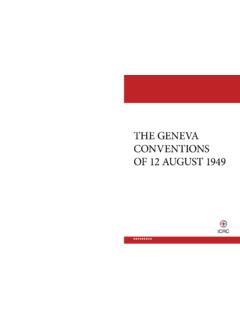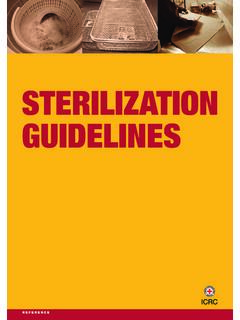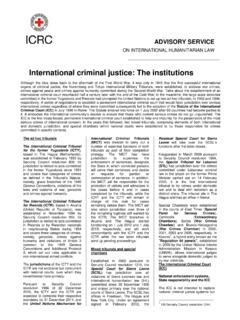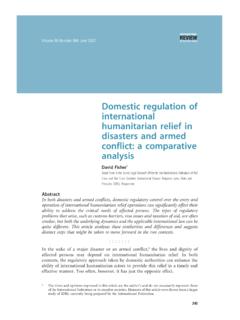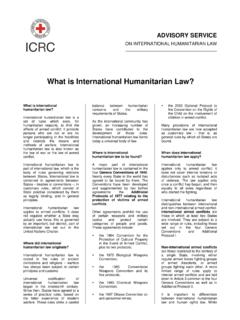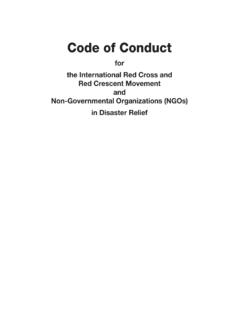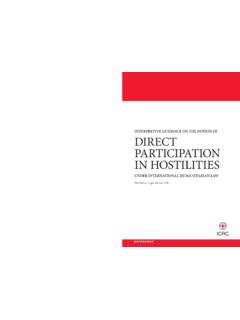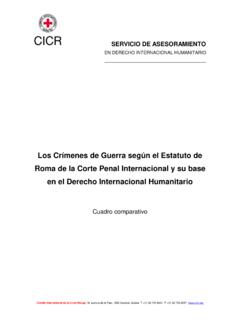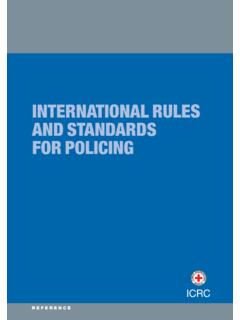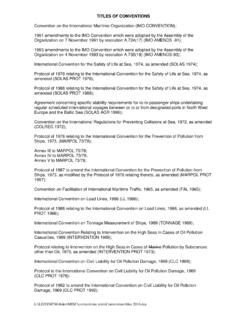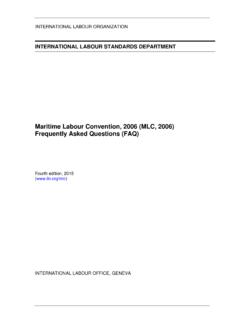Transcription of the Domestic implementation of international …
1 The Domestic implementation of international humanitarian lawa manualICRC national implementation database Treaty database and States Party Domestic implementation OF international humanitarian LAWA MANUALG eneva, Mont Blanc bridge. Flags on the occasion of the 30th international Conference of the Red Cross and Red Crescent. Jorge Perez/FederationContentsFOREWORD ..5 AIM OF THIS MANUAL ..7 ACKNOWLEDGEMENTS ..9 CHAPTER ONE: INTRODUCTION THE BASICS OF IHL 11 CHAPTER TWO: IHL TREATIES AND NATIONAL implementation 17 CHAPTER THREE: IHL AND Domestic CRIMINAL LAW 27 CHAPTER FOUR: THE GENEVA CONVENTIONS AND THEIR ADDITIONAL PROTOCOLS 43 CHAPTER FIVE: TREATIES CONCERNING PEOPLE AND PROPERTY IN ARMED CONFLICT 63 CHAPTER SIX: WEAPONS TREATIES 79 CHAPTER SEVEN: THE international CRIMINAL COURT 119 CHAPTER EIGHT.
2 SUPPORT FOR IHL implementation 129 ANNEXESRELEVANT SITESBIBLIOGRAPHY12345678 CONTENTS35 ForewordThe people most severely affected by armed conflict are increasingly those who are not or who are no longer taking part in the fighting. international humanitarian law has been developed as a set of rules that aims at minimizing the effects of armed conflict on these groups. Its range of conventions and protocols embraces numerous subjects such as the protection of the wounded and sick, civilians, prisoners of war and certain property, as well as the restriction or prohibition of certain means and methods of warfare.
3 Some international humanitarian law treaties have been widely ratified. Indeed, the Geneva Conventions have now achieved universal acceptance and their Additional Protocols of 1977 are among the most widely accepted legal instruments. The universal ratification of some other humanitarian law treaties is, however, still a long way off. Adherence to these international conventions is only the first step. Respecting international humanitarian law requires that a number of concrete measures be taken at the Domestic level, even in peacetime, to create a legal framework that will ensure that national authorities, international organizations, the armed forces and other bearers of weapons understand and respect the rules, that the relevant practical measures are undertaken and that violations of humanitarian law are prevented, and punished when they do occur.
4 Such measures are essential to ensure that the law works when needed. To do this effectively requires coordination between various government departments, the military and civil ICRC has always had a recognized role in the development and promotion of international humanitarian law and, aware of the challenges attached to full compliance, it created an Advisory Service in 1996 to strengthen its capacity to provide services to States in this regard. This Manual on the implementation of international humanitarian Law, prepared by the ICRC s Advisory Service, is based on close to 14 years of experience in the field of implementation .
5 It covers the concrete steps required for the implementation of the Geneva Conventions and their Additional Protocols, the various weapons treaties, the Rome Statute of the international Criminal Court and other relevant treaties. It offers ratification kits, model laws and fact sheets as tools to ensure that the law and practice of States are in full conformity with the obligations that flow from humanitarian law treaties. I hope that this manual will be useful to governments in their work in ensuring the full implementation of international humanitarian law, as, without doubt, increased ratification and effective implementation are key to greater protection of victims of armed Jakob KellenbergerPresident of the international Committee of the Red CrossFOREWORD7 Aim of this manualThe ICRC s Advisory Service was established within the ICRC Legal Division in 1996.
6 Since then, the number of States that are parties to instruments of international humanitarian law (IHL) has increased significantly. Much work remains to be done by States, however, to ensure that the obligations set out in these instruments are adequately reflected in Domestic law and applied in practice. This manual has been drafted mainly for policy-makers and legislators, and for those assisting them in their efforts to comply with their obligation to ensure respect for IHL. It aims to assist them in the ratification of relevant instruments and to offer guidelines in the implementation process, thus enabling them to bring their laws and practice in line with the requirements of manual emphasizes general principles and obligations as much as possible; it does so in order to reach beyond differences in legal traditions and in levels of institutional development.
7 It follows a treaty-based approach: for instance, one important chapter (Chapter Four) is on the core instruments of IHL, the universally ratified Geneva Conventions of 1949 and their Additional Protocols of 1977 and 2005. Other chapters deal with complementary instruments concerning the protection of specific persons and property during armed conflict (Chapter Five), weapons (Chapter Six) and the international Criminal Court (Chapter Seven). All the chapters provide succinct overviews of the contents of treaties; they do not discuss a treaty s every provision in detail.
8 Because the manual is for use primarily by legislative drafters or those assisting them, it focuses on those provisions that require action in the form of legislative or regulatory measures. General information on IHL and its implementation is provided in the introductory chapters (Chapters One to Three), which also discuss the links between IHL and criminal law at the Domestic level. The manual offers some practical tools: an extensive bibliography with titles in English, French and Spanish as well as annexes containing model laws and guidelines developed by the ICRC and other specialized manual does not set out to provide definitive legal interpretations of the provisions of the instruments that it describes.
9 It should be regarded as a practical tool that the ICRC s Advisory Service makes available to all those involved in the implementation of IHL. It reflects the expertise accumulated during its close to 14 years of experience in implementing IHL. Combined with the ICRC s web-accessible databases on national implementation measures ( ), which provide examples of legislation and jurisprudence from countries around the world, and on IHL treaties and documents ( ), which show the current state of signatures and ratifications, this manual should provide a number of ICRC s Advisory Service on IHL stands ready to assist States in their efforts to further respect for IHL obligations.
10 It may be contacted through its network of regional legal advisers or in Geneva at the address below:Advisory Service on IHLI nternational Committee of the Red Cross19, avenue de la PaixCH 1202 Gen veTel.: +41 22 734 6001 Fax: +41 22 733 2057E-mail: OF THIS MANUAL9 ACKNOWLEDGEMENTSA cknowledgementsThe ICRC Advisory Service is grateful to all those persons and organizations that have contributed to the drafting of this manual, which is the result of intensive teamwork. It would particularly like to thank those organizations that have permitted the reproduction of some of their documents concerning the implementation of international humanitarian law.
